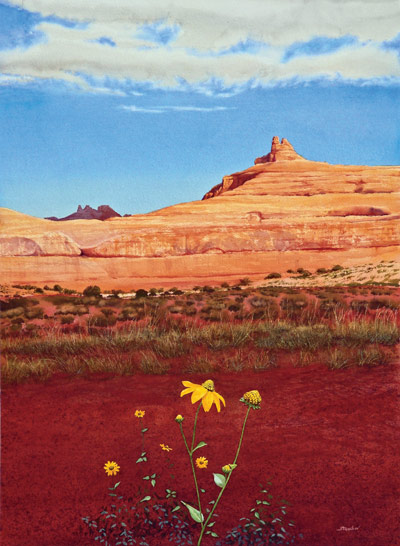Painting a Western Landscape | Demonstration in Watercolor

One Moment on a Grand Scale: Gregory Strachov

While hiking along a canyon near the Colorado River in Utah, I saw what looked like petrified dunes, majestic and luminous, glowing in the sunrise. I attempted to memorize the color, which was changing as each cloud produced a slow-motion strobe effect. I wanted to paint the scene, conveying the size and scale of the place along with the glow of the distant petrified dunes, so that the viewer could experience the scene and feel its beauty.
A single formation of a dune on which fell the only visible shadow fascinated me. I took a photo of the rocks in the distance, sketched the landscape with pencil and recorded thoughts and observations. Anything else that would go into the painting would come from interpretive memory.

1. Create a Color Study
I thought about this painting for several months before creating a color study in acrylic on brown wrapping paper. This study enabled me to work out the composition without wasting good materials. I wanted to establish the size and shape of the flower and to see the shape of the distant landforms in relation to the rest of the painting. I created shapes and forms and let intuition determine whether they worked or not.

2. Apply the Sky Wash
I stretched a wet sheet of 18×24-inch, 140-lb. Arches rag paper on a board, let it dry and then taped off the edges to hide the staples (which might otherwise hold and then release water into the painting). Then, after wetting the paper in what would become the blue-sky area, I applied a mixture of Naples yellow, permanent blue and phthalo blue, letting the mixture flow through the wet area. The sky wash is critical because it establishes the value to which all other values are compared. The clouds, which balance the landscape below and also provide an explanation for the shadows in the landscape, are simply unpainted areas. I released tiny amounts of water from the point of the brush to let the blue flow into the clouds, forming delicate irregularities on their edges.

3. Start the Flower and the Rock Formations
When the sky was dry, I applied a liquid mask on the flower, stem and leaves and then began working on the distant rock formations. To achieve the desired luminosity, I created a variety of mixtures out of yellows, reds, some yellow ochre and burnt sienna and then applied the colors in very thin transparent glazes.

4. Evaluate the Sky and Dune Contrast
I completed the dune and then evaluated the contrast between the sky and the dune. Because the sky is complex, it would have been damaged if I’d wet it again. When wet, watercolor paint is a different hue and value than it is when dry, and experience is the best way to predict the final appearance of a color. Remember, you cannot correct a watercolor; attempting to do so will make the painting look overworked. For this reason, if the contrast had not been correct, I would have discarded the watercolor and begun again.

5. Begin Working on the Middle Ground
I began working on the middle ground. I wanted to create the illusion of vastness by distributing the plants, changing their relative size and using a variation of values to indicate the distance. Making some areas more luminous than others suggests the distribution of clouds, which further adds to the illusion of vastness.

6. Paint the Foreground
To work out the distribution of leaves and stems on the flower, I bought a specimen from a garden center. Selecting an uncommon stem pattern, I pruned away the rest of the plant. I also experimented by painting different patterns on sheets of clear Mylar acrylic and overlaying them on the color study. I wanted the flower’s shape and pattern to look spontaneous, convey a strong, silent presence and yet remain faithful to the botanical characteristics of the plant. Once I’d worked out and masked the entire flower, I painted its background. At this point, I noticed that the land mass wasn’t bright enough, so I went over key areas with orange and yellow washes.

7. Finish the Flower and the Clouds
After I’d completed the background, I removed the mask from the flower. The stems required several layers of watercolor to bring out the reflected and refracted light on their cylindrical shape. To seem credible to the viewer, the flower had to be more detailed and accurate than the background. To tone down the clouds, I wet some areas and applied small washes. To prevent the water from forming boundaries as it dried, I kept the paint moving with the brush until I’d completed the wash, thus finishing Desert Bouquet (watercolor, 24×18).
To read more about Gregory Strachov and painting western landscapes, check out the July/August 2011 issue of The Artist’s Magazine.
RELATED ARTICLES
Gregory Strachov | Unique Landscapes in Watercolor
Gregory Strachov | Stories Behind Two of Gregory Strachov’s Paintings
Strachov receives Medal for Lifetime Achievement in the Arts
Free artistsnetwork.tv preview
Click here to watch a free video preview of “Chinese Watercolor Techniques with Lian Quan Zhen.”
MORE RESOURCES FOR ARTISTS
• Watch art workshops on demand at ArtistsNetwork. TV
• Online seminars for fine artists
• Instantly download fine art magazines, books, videos & more
• Sign up for your Artist’s Network email newsletter & receive a FREE ebook





Have a technical question?
Contact UsJoin the Conversation!